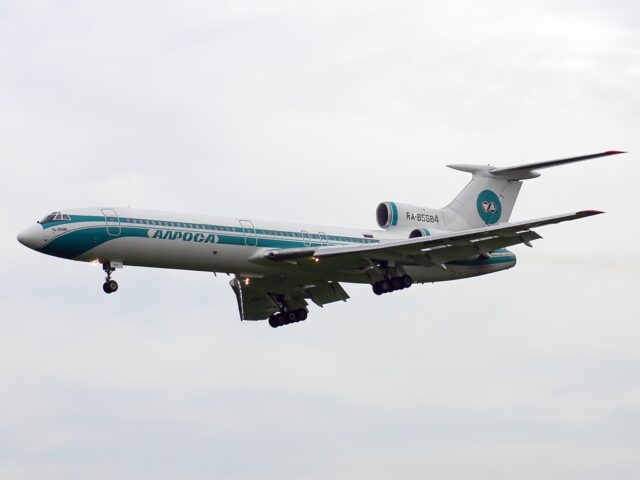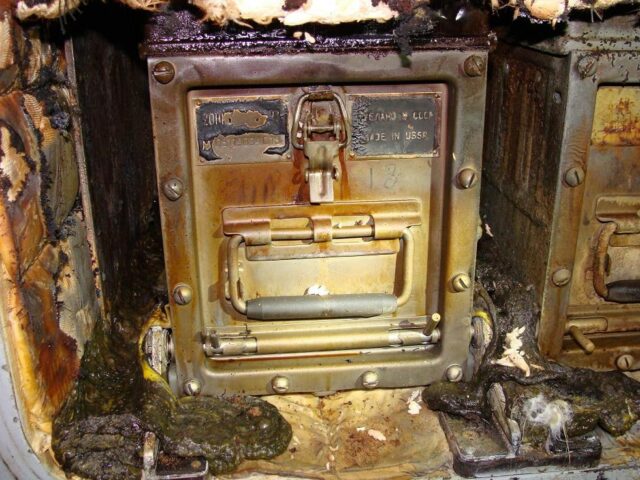The “Lucky” Landing of the Tupelov Tu-154
On the 7th of September 2010, a Tupelov Tu-154M (registration RA-85684) suffered a complete loss of electrical power during a cross-country flight to Moscow. The Tupolev Tu-154 is a three-engine Soviet jet originally developed to meet Aeroflot requirements for a medium-range airliner. Production started in 1970; the last TU-154 was manufactured in 2013 by Aviakor who also held four unfinished airframes in their factory to complete in case any further orders arrived. They never did.
The Tu-154M entered mass production in 1984 and is the most upgraded model. In 2010 Aeroflot announced the retirement of its Tu-154 fleet but various other operators remained, including Russian passenger airline Alrosa Mirny Air Enterprise (now Air Company ALROSA). Alrosa airline was founded by the Russian mining company ALROSA with bases at Mirny Airport and Palyarny Airport.

In the early hours of that Tuesday morning, the Tu-154M departed Palyarny Airport in Udachny normally with 72 passengers on board and nine crew, four flight crew and five cabin crew. The estimated flight time was five hours to Domodedovo Airport in Moscow. The four flight crew for a Tu-154M is likely to have been captain, first officer, flight engineer and navigator.
About three hours into the flight, at 7am, they were in the cruise at 10,600 metres (FL348) and passing over Usinsk (where ten years later a passenger plane would fly into a snow bank on final approach) when the autopilot disconnected.
The aircraft shuddered. In the cabin, the passengers thought they’d flown into turbulence. The flight crew immediately began a descent but they managed just one radio call to Air Traffic Control before the electrical system of the aircraft shut down completely. The Tu-154M lost lighting and navigational systems, of course, but also the radio, so they had no way of receiving assistance. On top of all that, they lost the electric fuel pumps which were pumping the fuel from the wing tanks to the engine supply tank.
Simon Hradecky of Aviation Herald explains:
The Tupolev TU-154 features 2 fuel tanks in the center section and 4 wing tanks, total capacity 39,750 kg (87550 lbs) for a maximum range of 3500nm with reduced payload. The electric fuel main pumps move the fuel from those tanks to an engine feed tank (capacity 3300 kg of fuel), also located in the center section of the aircraft, from where all engines are being supplied. Standby fuel pumps are available to transfer fuel to the engine feed tank with battery power. The failure of both main and standby fuel pumps would leave the crew with just the 3300kg of fuel in the engine feed tank sufficient for about 20-40 minutes flying time. Although the flaps are driven by hydraulics, the flaps handle switches are electric.
The flight crew quickly did the same math and realised they only had enough fuel for half an hour of flight. They dumped the useless fuel in their wings and descended further, searching for a place to land. One account says that they used a glass of water as an artificial horizon in order to keep level.
The local weather was overcast with a cloudbase at 400 metres (1,300 feet). Temperatures were just above freezing and light winds. As they broke through the clouds, out of options, they descended for an emergency landing on the River Izhma running through the sparse taiga forest.
Then, miraculously, they spotted a runway: an airfield that was not on their charts. One of the pilots later said, “I thought I was going crazy.”

Izhma Airport, in Komi, is a former military airfield for small aircraft, with examples including the An-2, An-24, L-14, and Yak-40. However, the airfield had been closed to fixed-wing traffic seven years earlier, in 2003. The concrete runway, 1,325 metres long (4,350 feet), was no longer officially maintained and had been removed from aeronautical charts. However, the airport was still open to helicopters. The airfield had only one staff member, the airport supervisor, which was a part-time position. The airport supervisor took it upon himself to keep the runway clear of vegetation and debris, just in case.
Although 1,325 metres is just over the minimum landing distance for a Tupolev TU-154, this was the M model, with a longer range and a higher take-off weight, and it needed twice the amount of runway for a safe landing. Without electrics, the flight crew could not extend the flaps or the slats to allow for a slower approach. But they were out of options. They asked the cabin crew to reseat the passengers at the front of the aircraft, perhaps for a better weight distribution or simply to ensure they could evacuate quickly from the main passenger doors at the front of the aircraft, keeping clear of the engines.
At the same time, Air Traffic Control requested all aircraft in the area to search for the worryingly silent Tu-154M. Emergency services in the area thought of the abandoned runway and sent vehicles to Izhma Airport, just in case they were needed.
The pilots made a low approach and then broke off and went around. A second attempt to land was also aborted. On the third try, at 07:55 am, the Tu-154M touched down at a speed of 350-380 km/hour (190-205 knots). They barrelled down the runway and beyond, through the small birch and pine trees of the surrounding taiga forest. The aircraft finally came to a halt in the soft ground at 160 metres (520 feet) off of the end of the runway. The crew and passengers escaped the aircraft using the evacuation slides.
A passenger took this 20-second video at the site, showing a surprisingly intact aircraft:
There were no injuries. In fact, according to The Moscow Times, the rescuers arrived to find the passengers foraging for mushrooms in the forest while they waited. They were taken to the local village, where they were fed (hopefully sharing their mushrooms) and given accommodation for the night, Then they were taken to Ukhta Airport by helicopter, where another Tu-154 was waiting to fly them to Moscow. One couple refused the offer of a flight and took the train instead.
The preliminary investigation noted that an unspecified disruption to the plane’s power supply caused the electrical failure, which was already pretty clear. The pilots were hailed as heroes. In contrast, the airline representative’s comment to the local press seems a bit luke-warm:
“In such circumstances, few can land such a heavy aircraft at an absolutely unprepared airfield. There might have been a bit of luck, too.
I was also amused by what feels like a throw-away reference to another incident that is slightly more well-known in the West.
Valentin Dudin, a former pilot and an expert in aviation security, said the landing was a rare but not unique event. In January 2009, an Airbus crash-landed in the Hudson River in New York with 155 people on board and no casualties.

The investigation, released in Russian only, found that the power outage was caused by the batteries overheating. This caused a thermal runaway, a type of uncontrolled positive feedback, where the increased temperature releases more energy, increasing the temperature even more.

The two active pilots were given the highest honorary title in Russia, Hero of the Russian Federation. The remaining crew were awarded the Order of Courage to recognise selfless acts of courage and valour. The airport supervisor who had kept the disused runway clear was awarded a medal “For Merit to the Fatherland” for his diligence.
The aircraft was not awarded any medals; however it was recovered from the forest as it had received only minimal damage. However, Izhma’s runway of just 1,300 metres was of course not enough: the Tu-154M requires 2,500 metres (8,200 feet) to take off.
Two of the three engines were removed and replaced. Everything that could be taken off the aircraft, was. Six months after the accident, two test pilots came to Izhma to attempt to fly the stripped-down craft 160 kilometers (100 miles) to a more sensible airfield. They were able to lift off after only 800 metres (2,600 feet). They flew a “farewell circle” around the aiport and then climbed to 3,600 metres, leaving the landing gear down as they weren’t sure, if they retracted the gears, that they would extend again. It was a twenty minute flight to Ukhta Airport.
If you’d like to watch the whole event, this 40-minute Russian video documents the set-up and take off of the stripped down Tu-154M. The actual take off from Izhma is around the 27-minute mark.
From Ukhta Airport, the Tu-152M was ferried to Samara, where it was repaired over the course of six months and given the name Izhma for its return to service.
On the 29th of September 2018, the first officer from the accident captained the Tu-154M for its last flight from Mirny to Novosibirsk. The Tupolev registered as RA-85684, manufactured in 1990 with 28 years of flying, is now at Tolmachevo Museum of Aviation in Novosibirsk. Alrosa Airline was the last Russian passenger airline to maintain the Tu-154 in their fleet; their final passenger flight in a Tupolev was in October 2020.








Ah, great! Another happy story!
All those involved did a great job.
The flight crew in particular must be commended. A pity that their names have not been released. Was it Captain Sullenkovsky?
But all crew members deserved the praise and honour that they were awarded, as well as the airport supervisor.
It testifies to the built quality of the TU 154 to. Not many aircraft survice a crash such as this one.
All those aboard can also count themselves lucky that the runaway battery did not explode.
But what really brought a grin to my face was reading about survivors going out into the woods after the crash to gather mushrooms.
Mr. Putin should be made to realize that he is not taking good care of the Russian citizens, who deserve better, much better !
A micro cross-section of some of the best Russian people. Stoic, resourceful and uncomplaining. Many of whose sons are thrown into a war to die, just for the glory of their leader.
Finished your sentence: “originally developed to meet Aeroflot requirements for a medium-range airliner just like the L-1011” :-)
Hm, a glass of water won’t work as an artificial horizon, due to centrifugal force. It’ll simply replicate the ball in the turn-n-bank indicator. And of course it’ll detect dinosaurs.
“The airport supervisor who had kept the disused runway clear was awarded a medal” – Yes, I love a happy ending.
Once again, I totally agree with Rudy.
During my time in Eastern Europe and Western Asia, just after the Wall came down, I had the opportunity to fly with several Soviet era Pilots. They were all excellent aviators. I rate their training on the same level as we train USMC pilots.
I’ll save my rant against “Pilot Farm” trained pilots until Sylvia gives us her take on the recent Oshkosh crashes.
Thanks to Sylvia for this artical. I was totally unaware of this event.